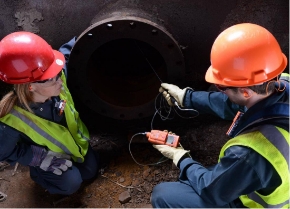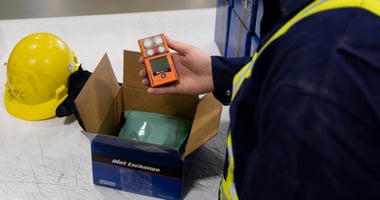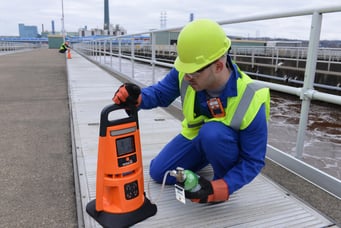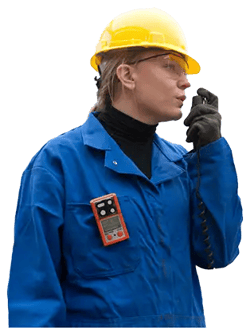Since the introduction of electronic gas detectors, workers have used gas monitors with pumps to get their jobs done safely and effectively. However, any time you add a new capability to a tool, there are bound to be questions—especially when that device stands between you and exposure to a potentially hazardous environment.
As workers suit up for their shift, they may wonder: Does this job require a pumped gas detector? How do I use a pump to sample gas? Will using a pump better protect me?
These questions are crucial to consider. Read on to learn more about choosing a gas monitor for your application—pump or no pump.
Common Misconceptions about Pumped Gas Detectors
Many people believe that every gas monitor should have a pump. Some of the misconceptions I have heard in the field are that gas monitors without a pump are less accurate, slower to respond, or don’t detect as much gas. Simply put, these are all false.
Pumps don’t increase the range of detection or the effectiveness of the gas monitor. The gas monitor’s sensors will still only detect the gas that they come in direct contact with. Having a pump on a gas monitor does not increase the amount of gas the sensors read.
Rather, the pump allows you to test the atmosphere at a distance from the gas monitor. Therefore, if you place two detectors next to each other and one has a pump with no tubing attached, it will not detect the hazardous gases any faster than the unit without the pump. Both units will read the same.
While having a pumped gas monitor does not mean it’s more accurate, quicker to respond, or able to cover more area around you, it will make performing certain tasks remarkably easier and safer.
Let’s cover some of the reasons you may want to consider using a pump with your gas monitor.
When to Use a Pump with a Gas Detector
 Pumped gas monitors allow you to easily pull the air from an unknown, potentially toxic or combustible, atmosphere to your location so that you can view the monitor’s results in an area that you know to be safe. Pumps literally keep you out of harm’s way.
Pumped gas monitors allow you to easily pull the air from an unknown, potentially toxic or combustible, atmosphere to your location so that you can view the monitor’s results in an area that you know to be safe. Pumps literally keep you out of harm’s way.
After you’ve assessed the air sample using a pumped gas monitor and confirmed it is clear of any toxic or combustible gases, you can enter the tested area and get to work.
You may encounter a vessel that is not very tall but spans a distance of thirty feet or more. In this type of confined space entry, a pump with an extendible probe allows you to slowly advance into the space with the probe ahead of you, ensuring that the atmosphere is safe prior to entering further.
Other times, the vessel may be tall and narrow, requiring an entry from above. In this instance, using a pump and sufficient tubing will allow you to check from above that the entire vessel has been completely cleared of any hazardous gases prior to entry. In both of these examples, you are allowing the pump and sampling equipment to pull the air to the monitor prior to entry, helping you avoid danger.
We’ve seen how having a pump on a gas monitor can make operations easier and safer; however, using a pump doesn’t always make sense. So what are some scenarios or applications when you should avoid using a pumped gas detector?
Why Not Use a Pump with a Gas Monitor?
What is the downside of always using a pump? While the gas monitor will detect gas in the same manner whether it has a pump on it or not, a monitor with a pump will certainly be larger and heavier. Also, the pump will use some of the gas monitor’s battery, resulting in a shorter run time overall.
Since operators typically wear a gas monitor throughout their entire workday—which could extend to twelve or more hours—having a gas monitor that is small, lightweight, and runs the entire shift is critical.
Because of this, most people would agree that it is better to save the pumped monitor for where it is absolutely necessary.
Other Things to Consider When Using Pumped Gas Detectors
Once you have decided that a pumped monitor is the best choice for your job, you will want to make sure you have any other accessories you need to effectively use and protect your pumped monitor. If you’re doing a horizontal entry or using the pump to check areas that are difficult to reach, you will want to use a probe. This may be a lightweight polycarbonate probe, an extendable stainless-steel probe, or perhaps a probe designed to withstand high temperatures.
If you are doing a vertical entry, you are going to need some tubing. Commonly, you will see urethane and Teflon-lined tubing. Urethane tubing is suitable to sample gases except for chlorine, chlorine dioxide, hydrogen chloride, and volatile organic compounds (VOCs). Chlorine, chlorine dioxide, hydrogen chloride, and VOCs can be absorbed by urethane tubing, leading to inaccurate readings. For this reason, Teflon-lined tubing is recommended for use with these gases.
Any time you are using a pump with tubing, it is important to allow enough time for the gas sample to travel the length of tubing and diffuse into the sensors. A good rule of thumb is to allow two seconds for each foot of tubing, plus two minutes for the sensors to read and stabilize. That means if you have thirty feet of tubing attached to your pump, you should wait three minutes to get an accurate reading of the gas at the end of that tubing.
Another important tip when using a pumped gas monitor is to use a dust filter and water stop at the end of the tubing or probe. In addition to preventing damage from dust and debris, it will prevent liquid from being pulled into the pump motor should the end of the tubing get dropped into any liquids.
Whether you are working in a water treatment plant and verifying that a tank is free of gases prior to its maintenance or checking for leaks among a number of hard-to-access valves and piping in a refinery, using a pumped gas monitor will keep you out of harm’s way.
For personal monitoring applications where remote sampling is not required, consider sticking with a non-pumped monitor. This gives you flexibility to add a pump in the field later if the need arises with our Ventis® Slide-on Pump.
The Ventis Slide-on Pump is ideal for operators who wear their gas monitors for personal protection but occasionally need a pump for confined space entries. Available in black or safety orange and powered by its own battery pack, the slide-on pump is compatible with the Ventis® MX4 and the Ventis® Pro5 Multi-Gas Monitors.
To learn more about confined space entry, download our complete guide.



